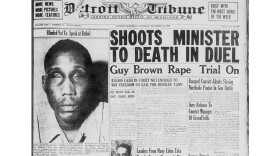-
"P" is for Prehistoric South Carolina. During the last Ice Age human groups may have made their way to what became South Carolina as early as 18,000 years ago—but a time frame of 13,000 years ago is widely accepted by archaeologists.
-
"P" is for Prehistoric South Carolina. During the last Ice Age human groups may have made their way to what became South Carolina as early as 18,000 years ago—but a time frame of 13,000 years ago is widely accepted by archaeologists.
-
In War Stuff: The Struggle for Human and Environmental Resources in the American Civil War, her path-breaking work on the American Civil War, Joan E. Cashin explores the struggle between armies and civilians over the resources necessary to wage war.This war 'stuff' included the skills of white Southern civilians, as well as such material resources as food, timber, and housing. At first, civilians were willing to help Confederate or Union forces, but the war took such a toll that all civilians, regardless of politics, began focusing on their own survival. Dr. Cashin talks about this history with Walter Edgar, and about the efforts of historians to establish a precedent for the study of material objects as a way to shed new light on the social, economic, and cultural history of the conflict.
-
In War Stuff: The Struggle for Human and Environmental Resources in the American Civil War, her path-breaking work on the American Civil War, Joan E. Cashin explores the struggle between armies and civilians over the resources necessary to wage war.This war 'stuff' included the skills of white Southern civilians, as well as such material resources as food, timber, and housing. At first, civilians were willing to help Confederate or Union forces, but the war took such a toll that all civilians, regardless of politics, began focusing on their own survival. Dr. Cashin talks about this history with Walter Edgar, and about the efforts of historians to establish a precedent for the study of material objects as a way to shed new light on the social, economic, and cultural history of the conflict.
-
In this week's episode of Walter Edgar's Journal, Richard Gergel details the impact of the 1946 blinding of Sergeant Isaac Woodard on both President Harry S. Truman and Judge J. Waties Waring, and traces their influential roles in changing the course of America's civil rights history.Woodard, a returning, decorated African American veteran of World War II, was removed from a Greyhound bus in Batesburg, South Carolina, after he challenged the bus driver’s disrespectful treatment of him. Woodard, in uniform, was arrested by the local police chief, Lynwood Shull, and beaten and blinded while in custody.
-
In this week's episode of Walter Edgar's Journal, Richard Gergel details the impact of the 1946 blinding of Sergeant Isaac Woodard on both President Harry S. Truman and Judge J. Waties Waring, and traces their influential roles in changing the course of America's civil rights history.Woodard, a returning, decorated African American veteran of World War II, was removed from a Greyhound bus in Batesburg, South Carolina, after he challenged the bus driver’s disrespectful treatment of him. Woodard, in uniform, was arrested by the local police chief, Lynwood Shull, and beaten and blinded while in custody.
-
In the months following the May 1780 capture of Charleston, South Carolina, by combined British and loyalist forces, British soldiers arrested sixty-three paroled American prisoners and transported them to the borderland town of St. Augustine, East Florida—territory under British control since the French and Indian War.In their new book, Patriots in Exile: Charleston Rebels in St. Augustine during The American Revolution (2020, USC Press), James Waring McCrady and C. L. Bragg chronicle the banishment of these elite southerners, the hardships endured by their families, and the plight of the enslaved men and women who accompanied them, as well as the motives of their British captors.Bragg joins Walter Edgar to talk about this little known chapter of the Revolution.
-
In the months following the May 1780 capture of Charleston, South Carolina, by combined British and loyalist forces, British soldiers arrested sixty-three paroled American prisoners and transported them to the borderland town of St. Augustine, East Florida—territory under British control since the French and Indian War.In their new book, Patriots in Exile: Charleston Rebels in St. Augustine during The American Revolution (2020, USC Press), James Waring McCrady and C. L. Bragg chronicle the banishment of these elite southerners, the hardships endured by their families, and the plight of the enslaved men and women who accompanied them, as well as the motives of their British captors.Bragg joins Walter Edgar to talk about this little known chapter of the Revolution.
-
“J” is for Johns, Jasper (b. 1930). Artist. Jasper Johns is a pivotal figure of twentieth-century American art, occupying a critical position that mediates Abstract Expressionism, Pop Art, and Minimalism.
-
“J” is for Johns, Jasper (b. 1930). Artist. Jasper Johns is a pivotal figure of twentieth-century American art, occupying a critical position that mediates Abstract Expressionism, Pop Art, and Minimalism.

Play Live Radio
Next Up:
0:00
0:00
Available On Air Stations





